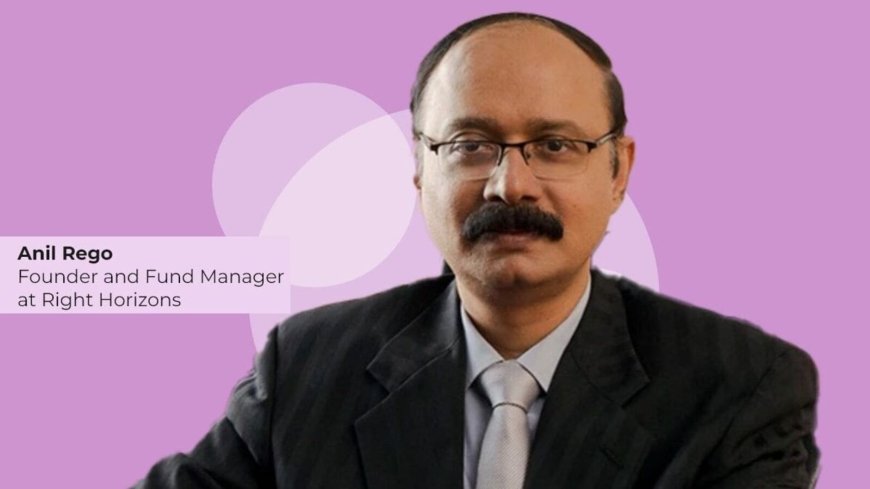Expert view: Nifty EPS may grow at a 13% CAGR over FY25–FY27, says Anil Rego of Right Horizons PMS
Anil Rego of Right Horizons PMS projects 13% CAGR growth in Nifty EPS over FY25–FY27, citing strong sectoral fundamentals and India’s economic momentum.

In a strong endorsement of India’s corporate earnings trajectory, Anil Rego, Founder and Fund Manager at Right Horizons PMS, has projected a 13% compound annual growth rate (CAGR) in Nifty EPS (Earnings Per Share) over FY25 to FY27. This bullish outlook comes amid India’s stable macroeconomic environment, easing inflation, and strong domestic demand that continue to support earnings resilience despite global uncertainties.
India’s Structural Growth Story Remains Intact
According to Rego, the structural reforms undertaken by the Indian government in the last decade—such as GST implementation, digital infrastructure, and capex-led spending—are beginning to show consistent benefits in corporate performance.
“We believe the Indian economy is poised for sustained growth, and this will reflect in corporate earnings. Over the next three years, we see Nifty EPS growing at around 13% CAGR, led by strong performances in banking, capital goods, auto, and select consumption-related sectors,” said Rego in an interview with a financial publication.
He emphasized that India’s premium valuations are justified by its strong fundamentals and long-term growth prospects.
Sectoral Drivers Behind EPS Expansion
Anil Rego highlighted multiple sectoral catalysts driving this robust earnings growth:
-
Banking and Financials: Credit growth remains healthy, and asset quality has improved significantly. PSU banks have also bounced back with improved profitability.
-
Capital Goods and Infrastructure: Government-led infrastructure push and increasing private capex are boosting order books for capital goods companies.
-
Auto and Auto Ancillaries: Rising disposable income, rural recovery, and new launches in EV and hybrid segments are supporting volume growth.
-
IT Services: Despite short-term headwinds from the US and Europe, Rego believes a bottoming out in FY25 will lead to normalized growth from FY26 onward.
“We are overweight on capital goods and domestic-facing sectors. Even within consumption, selective picks in staples and durables will do well due to rising rural demand,” Rego added.
Valuations and Market Outlook
India's equity markets have seen a strong run-up over the past year, with the Nifty 50 gaining over 22% in the last 12 months. Despite this rally, Rego believes there is still room for earnings-led growth.
The current forward P/E ratio for Nifty stands around 20–21x, slightly above the historical average. However, he believes this is not overstretched when viewed in the context of consistent earnings upgrades and improved ROE (return on equity) profiles across sectors.
“Valuations are fair when you factor in the consistent EPS growth trajectory. We advise a stock-specific approach and bottom-up investing rather than index-based allocation,” Rego said.
Macro Tailwinds Reinforcing Earnings Momentum
Several macro factors are aiding India’s growth engine:
-
Stable Inflation and Rate Cycle: With headline inflation moderating, the Reserve Bank of India (RBI) is expected to remain on pause, and a possible rate cut in early 2026 could further support economic activity.
-
FII and DII Flows: Foreign institutional investors (FIIs) have returned to Indian markets in FY25 after a net outflow in FY23. Meanwhile, domestic mutual funds and SIP inflows continue to show strong resilience.
-
Strong GST and Tax Collections: Higher indirect tax collections reflect robust consumption trends and formalization of the economy.
Risks to the EPS Growth Outlook
Despite optimism, Rego cautions that global risks could temporarily impact India’s earnings growth. These include:
-
Geopolitical tensions in West Asia or the Taiwan Strait that could disrupt supply chains.
-
A sharp slowdown in the US or EU affecting IT and export-heavy sectors.
-
Volatility in crude oil prices and its potential impact on India’s fiscal balance and inflation.
“Investors should brace for interim volatility, especially with global elections and macro shifts. But India remains among the best-placed economies from a long-term investment standpoint,” Rego asserted.
Investor Strategy: Focus on Fundamentals, Avoid Herd Mentality
Rego advises investors to focus on long-term fundamentals rather than market noise. He recommends a diversified portfolio tilted toward earnings visibility, capital efficiency, and strong management track records.
For retail investors, systematic investment plans (SIPs) remain the best route to tap into India’s growth while averaging out volatility.
“This is a stock picker’s market. We’re seeing mid- and small-cap segments outperform, but one must be cautious about chasing overvalued names. Stick to quality with reasonable growth expectations,” said Rego.
The projected 13% EPS growth in Nifty over FY25–FY27 reflects strong underlying fundamentals and a supportive policy environment. As India inches closer to becoming the third-largest economy by 2027, the equity markets are likely to remain a preferred asset class for both domestic and global investors.
For now, prudent stock selection, disciplined investing, and a long-term horizon remain the keys to capitalizing on India’s economic potential.
What's Your Reaction?
 Like
0
Like
0
 Dislike
0
Dislike
0
 Love
0
Love
0
 Funny
0
Funny
0
 Angry
0
Angry
0
 Sad
0
Sad
0
 Wow
0
Wow
0













































































